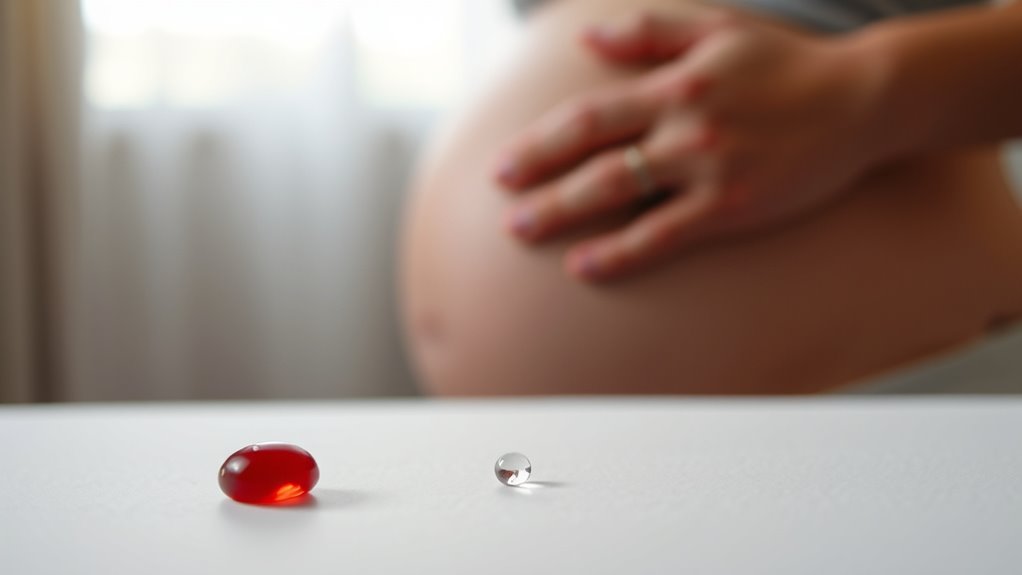Implantation bleeding usually occurs 10 to 14 days after ovulation and can be easy to confuse with a light period. It appears as light spotting, typically pink or brown, lasting from a few hours to three days. There are usually no clots, and it’s often accompanied by mild cramping. If you experience heavier bleeding or intense discomfort, consult a healthcare provider. Stick around to discover more about identifying and distinguishing implantation bleeding from your menstrual cycle.
Key Takeaways
- Implantation bleeding occurs 10 to 14 days after ovulation and is a sign of early pregnancy.
- It typically lasts a few hours to three days and is lighter than menstrual bleeding.
- The blood color ranges from light pink to dark brown, with no clots present.
- Mild cramping may accompany implantation bleeding, but it’s usually less intense than menstrual cramps.
- Consult a healthcare provider if experiencing heavy bleeding or severe discomfort during this time.

When you’re trying to conceive, noticing any unusual spotting can be both exciting and confusing. One possible explanation for this spotting could be implantation bleeding, which occurs when a fertilized egg attaches to your uterine lining. This usually happens about 10 to 14 days after ovulation, and it’s a normal part of early pregnancy that affects around 15-25% of pregnancies. The light bleeding you notice is often due to the breakdown of small blood vessels in the uterus during the implantation process.
Noticing unusual spotting while trying to conceive may indicate implantation bleeding, a common sign of early pregnancy.
Timing is crucial when it comes to identifying this type of bleeding. Implantation bleeding often coincides with the time you’d expect your menstrual period, which can make it tricky to distinguish. Typically, this spotting lasts from a few hours to a few days, but it generally doesn’t exceed three days. Unlike a regular period, implantation bleeding occurs before you notice a missed period, and it usually stops on its own without any treatment.
In terms of appearance, implantation bleeding is usually light and resembles spotting rather than a full menstrual flow. The blood can range from light pink to dark brown, and you likely won’t see any clots—unlike you might during menstruation. The flow is so light that you may only need a panty liner. You might notice just a single spot or a streak of discharge, making it even more puzzling.
To differentiate between implantation bleeding and your menstrual cycle, consider the heaviness and duration. Menstrual bleeding is typically heavier, lasts longer, and the blood tends to be bright red or dark red. You’d also likely experience more intense cramps during your period. If you experience mild cramping alongside the spotting, it could be indicative of implantation, as this can occur when the embryo attaches to the uterine wall.
It’s also worth noting that early pregnancy symptoms often accompany implantation bleeding. You might feel nausea, fatigue, or tenderness in your breasts. Mood swings, headaches, and an increased sense of smell are common, as is frequent urination.
While light spotting isn’t usually a cause for concern, heavy bleeding or significant discomfort warrants immediate medical attention, as these could indicate complications like ectopic pregnancy or miscarriage.
If you suspect you’re experiencing implantation bleeding, waiting a few days after the spotting stops might give you a more accurate pregnancy test result. Consulting a healthcare provider can also help clarify any concerns about your bleeding. Remember, any unusual bleeding during pregnancy should be evaluated to ensure everything’s progressing smoothly.
Frequently Asked Questions
How Long Does Implantation Bleeding Typically Last?
When it comes to understanding the delicate dance of your body, implantation bleeding often lasts just a few hours to a couple of days.
Most experiences fall between 1 to 2 days, rarely stretching beyond three.
Unlike your regular menstrual flow, this gentle spotting might catch you off guard, appearing in shades of brown or pink, signaling something new is blossoming within.
Can You Have Implantation Bleeding With a Regular Period?
You can’t have implantation bleeding and a regular period at the same time.
Implantation bleeding occurs before your expected period, usually 10-14 days after conception. While it might seem confusing due to similar timing, these are separate events.
If you notice light spotting and mild cramping earlier than your period, it’s worth taking a pregnancy test.
If you’re unsure or have concerns, don’t hesitate to consult a healthcare provider for clarity.
Is Implantation Bleeding Always a Sign of Pregnancy?
Think of implantation bleeding like a whisper in the world of pregnancy; it’s subtle but can carry meaning.
However, it isn’t always a sign of pregnancy. While light spotting can indicate implantation, other factors might cause similar bleeding.
It’s crucial to consider your cycle and any additional symptoms. If you’re unsure, keep an eye on your body’s signals and consult a healthcare provider for clarity and peace of mind.
What Color Is Implantation Bleeding Usually?
Implantation bleeding usually appears in pale pink, brown, or rust colors.
You’ll notice that it tends to be lighter and less intense than typical menstrual blood. As it progresses, the color may change from light pink to brown.
Unlike menstrual bleeding, you shouldn’t see any clots with implantation bleeding. If you experience this, it’s often a sign that something significant might be happening in your body.
Can Stress Affect Implantation Bleeding?
Did you know that about 25% of pregnant individuals experience implantation bleeding?
Stress can definitely impact this process. When you’re stressed, your body releases hormones like cortisol that might hinder the implantation of a fertilized egg.
This hormonal imbalance can affect how your uterus prepares for a new pregnancy.
Conclusion
In conclusion, being aware of the signs of implantation bleeding can help you understand your body better. Did you know that about 20-30% of pregnant women experience this early sign? If you notice light spotting accompanied by other symptoms like cramping or a missed period, it might be time to take a pregnancy test. Trust your instincts and seek medical advice if you’re uncertain. Staying informed can make all the difference in your journey to motherhood!









